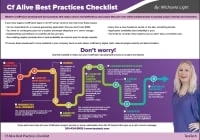Jorge Reyes talks about ColdFusion High-Performance Teams with some tips in this episode of ColdFusion Alive Podcast with host Michaela Light.
Contents
Show notes
Why High-Performance Teams
- Distrust
- Fear conflict
- Lack of commitment
- Avoid accountability
- Inattention to results
What do you mean by High Performance
- Efficient
- Reliable
- Effective
- Consistent
- Predictable – Product expected results
The Projectized Organization
- PM is king
People > Process
- Servant Leadership
- Team rules and processes
- Help team members grow in tech and interpersonal skills
- Generalizing specialists
- Empower and encourage emerging leaders
- Learn team motivators and demotivators
- Encourage communication via slack or other collaboration tools
- Shield team from distractions
- Track performance and forecast
- Share project Vision
Agile teams vs hierarchical teams
- Self-organizing
- Servant Leader-Facilitator
Everyone knows their Roles
Biz representatives – does and don’t
Can
- Prioritizes features
- Makes change requests
- Provides the acceptance criteria
Can not
- Change features or priorities
- Decide due date
- Attend planning meetings or retrospectives
Scrum master
- Facilitates team and biz reps
- Coaches
- Servant leader
- Follows up
Project sponsor
Dev team
- Front End
- Code
- Test
- DevOps
Team > lone development or talent
- Even if Luis the CEO is on the team
Team Evolution
- Forming → storming → norming → performing
High-Performance Teams
- Performing stage of team evolution
- < 12 members
- Complementary skills
- Generalizing Specialists
- Can switch roles and hence resolve bottlenecks
- Committed to the common vision
- Buy into the company culture
- Team members are seen as important to the project
- Mutual accountability
- Shared ownership of project outcome
Skill learning
- Mentors
- Shu-Ha-Ri skill mastery
- Dreyfus model
- Novice → Beginner → Competent → Proficient → Expert
Motivation
Experimenting and Failing safely
- Constructive disagreement
- Honesty, transparent
- Values > tech skills
- “Throwing people into the fire”
- A hard task a bit above what they already know
- with the support of mentors
- For growth and motivation
Distributed teams
Team tools
- Video conferencing – Zoom
- Cameras on to see body language
- Focus on meeting
- IM – Slack and email
- Keban boards – Trello, JIRA
- Online calendar – Google, Outlook, iCal
Conf call tips
- Keep to time limits (15 min for stand-ups)
- Have a timekeeper on the team who pays attention and reminds
- Culture of integrity
- Start on time and end on time
- Agenda
- Very clear of expectations – be up front of my role as the meditator for meeting
- Document and record
Burndown chart
Burn up chart
- Estimating release date
Team velocity
CF summit
- Luis, Gavin, Jon from Ortus are speaking
- Post-summit training on ColdBox (2 days)
Ortus Roadshow – containers 2?
Why are you proud to use CF?
WWIT to make CF more alive this year?
What are you looking forward to at CF Summit in Las Vegas?
Mentioned in this episode
- CF Suicide episode
- Slides
- Book Turn the Ship Around!: A True Story of Turning Followers into Leaders by L. David Marquet
- 079 Help Your ColdFusion Team Find Flow (7 keys to PM success) with Christine Ballisty
- 060 Virtual Power Teams for ColdFusion Development (3 mistakes to avoid) with Peter Ivanov
- Stand up = daily stand up meeting = Scrum
- Zoom
- Slack
- Trello
- JIRA cloud
- Into The Box conference
Listen to the Audio
Bio
Jorge Reyes
Jorge is a passionate Industrial Engineer born in El Salvador with 7 years of experience managing projects. Business manager at Ortus Solutions, Corp.
Links
- Email: Jreyes (at) ortussolutions.com
- Ortus Solutions, Corp
Interview Transcript
Michaela:
Welcome back to the show. I'm here with Jorge Reyes from Ortus solutions, and we're gonna be talking about high performance cold fusion teams. We've got 15 tips and techniques that can make your competition teams really blossom. So we'll look at why you might want to have a high performance team. You don't have one already, and what exactly who he means by that. And we'll also look at how you can support your people over the process. And agile teams when everyone knows that we're all and you can help the T team and the team members evolve and look at some different ways you can improve the skills of your teams, and also some tool for work with distributed teams. So welcome. Whoa. Hey,
Jorge Reyes:
Michael. Thanks for having me again.
Michaela:
know, so yeah, you're so welcome. So maybe we should just start out with, you know, why should someone have a high-performance team? I know, that seems to seem we have a silly question, but not everyone has them.
Read more
And to continue learning how to make your ColdFusion apps more modern and alive, I encourage you to download our free ColdFusion Alive Best Practices Checklist.
Because… perhaps you are responsible for a mission-critical or revenue-generating CF application that you don’t trust 100%, where implementing new features is a painful ad-hoc process with slow turnaround even for simple requests.
What if you have no contingency plan for a sudden developer departure or a server outage? Perhaps every time a new freelancer works on your site, something breaks. Or your application availability, security, and reliability are poor.
And if you are depending on ColdFusion for your job, then you can’t afford to let your CF development methods die on the vine.
You’re making a high-stakes bet that everything is going to be OK using the same old app creation ways in that one language — forever.
All it would take is for your fellow CF developer to quit or for your CIO to decide to leave the (falsely) perceived sinking ship of CFML and you could lose everything—your project, your hard-won CF skills, and possibly even your job.
Luckily, there are a number of simple, logical steps you can take now to protect yourself from these obvious risks.
No Brainer ColdFusion Best Practices to Ensure You Thrive No Matter What Happens Next
ColdFusion Alive Best Practices Checklist
Modern ColdFusion development best practices that reduce stress, inefficiency, project lifecycle costs while simultaneously increasing project velocity and innovation.
√ Easily create a consistent server architecture across development, testing, and production
√ A modern test environment to prevent bugs from spreading
√ Automated continuous integration tools that work well with CF
√ A portable development environment baked into your codebase… for free!
Learn about these and many more strategies in our free ColdFusion Alive Best Practices Checklist.






